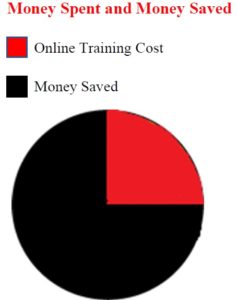Is Online Safety Training BETTER than Traditional Classroom Training?
Table of Contents
ToggleOnline or Classroom Safety Training
Online or Classroom Safety Training, What's Better. The short answer, ONLINE. But why is it better? I’ve got several answers that will show why, like 50% to 75% cheaper. But first I have to say, I actually instruct some classroom-based safety training courses. I designed and authored two courses based on Personal Fall Protection, whereas the second course has an Aerial Work Platform (AWP) element to it. Both courses are a full day in length and start at $200 per worker.
New and Young Worker
However, when it comes to an inexperienced New and Young Worker who’s never taken any safety training in their life, I do recommend a classroom with an instructor for the first time. In addition, most safety training in BC, other than a few programs, is only good for 3 years maximum. Then the worker needs to recertify training. The cost savings alone is one big reason to take online courses.
The Argument
For the purpose of argument, let’s say that worker uses their training almost daily. After 3 years of experience, they will have become very knowledgeable in regards to the safety courses they’ve acquired. Does it really make economic sense to recertify their training in the same fashion as the first course they took? From an employer’s point of view who might be footing the cost, I would say NO.
Recertify at a School
The only reason why that same person would benefit from the second round of classroom instruction would be if they only used the training a few times in 3 years. However, the daily user can recertify with a reputable online course. Now the question, how do you know it’s reputable? That’s easy to answer. Who else is using the same training courses? Search your local safety organizations, trade associations, and companies that are industry leaders.
Online Training Cost Comparison
So why is Online Safety Training Better than Classroom Training? First and foremost, Cost Comparison. Online training cost savings are 50% to 75%. For most companies, the difference is the cost is the difference between being compliant with safety regulations and not. I’ll give you an example. A reputable Fall Protection Training course when taken at a school will cost $200 per person on average.
Employer Payments
In addition, that doesn’t even include if the company has to pay this worker a whole day’s wage for sitting in a classroom. That’s another $200 or more, plus the loss of production from that worker. Only an employer can factor that cost in. To demonstrate, we’ll keep this cost at $400 spent per worker. Now let’s examine Fall Protection Training online. $49. 95 at the low end and only increasing to $99.95 at the very top. $400 compared to $100 to make it easy.
More Savings
Workers don’t have to sit in a classroom for 8 hours. Not to mention, the company doesn’t have to pay a day’s wages. To put it another way, if they purchased the most expensive course online, minus worker wages for a day, the company just saved $300.00. You only have to give up 25% of it. The rest the company keeps and puts back into their pockets. On the other hand, with a 4 -1 ratio they can purchase a block of 4 courses of the same training program for 3 other workers. Or better yet, push it to 8 workers and receive even better cost savings due to the amount purchased.
Classroom Fear
Another key point is Classroom Fear. I personally can attest to this issue. Through my childhood, teens, and well into my late twenties, I never really achieved in a classroom setting. Whether it be nerves, fear of giving a verbal wrong answer, or just the fact of it being school, some people do not do well in a classroom. No matter what their experience level is. This starts out when they are kids as this article describes, Fear of School Phobia.
Final Exam
The most compelling evidence of this is when writing a final exam that has some sort of time limit within a day-long training program. When rushed to find an answer, some people seem to forget all they just learned. Not because it isn’t within them. Surprisingly they forget because it’s a test in a classroom, pure and simple. I’ve had it happen to me, and I’ve seen it happen to students that I instructed.
More Comfortable at Home
When taking courses online people are at home, at the park, or at a beach, anywhere relaxing. As long as you have an internet connection, you’re good to go. As well, it's easier for recertification training. The pressure is non-existent. Now some will say pressure in industry or production in construction is the nature of the beast. However NOT in safety.
No Pressure
The second pressure develops on the job, you must slow it down and rethink the issue. That’s the beauty of online safety training, no pressure. You take your training courses at your own speed. That’s in contrast to a classroom setting where there is a set time limit in most training facilities. If you don’t complete the course and finish the test in the allotted time, it's a fail. Some institutions may even have that worker sit through another whole course because they failed the first one.
Conclusion
Given these points, online safety training is a much better choice for workers, employers, and the wallet over classroom training. All except for the New and Young Worker with absolutely no experience. It’s a classroom they need to go to for the first time, except for a basic course like WHMIS 2015 for workers. Which for the most part don’t need to recertify training. Maybe just some upgrading.
Honesty
Courses like that are somewhat easy to design. However, there is one factor not too many people mention when it comes to online training. That would be honesty. If a person is dishonest when it comes to the final exam for any course, the cost could be deadly. Mistakes made due to not knowing the answer because of dishonest courses completion could cost somebody's life in most heavy industries.
The Downside to Online Training
The downside to online training is, some individuals learn better with hands-on training. Having an instructor demonstrating an aspect of a training program can also be very beneficial. However, with companies purchasing blocks for their staff, for the most part, there is always a training coordinator with a company that can help with any issues. Is Online Safety Training BETTER? Yes, it is.
Online Safety Training Courses
Go to the Store and Browse Around

Online Safety Training with over 600 e-learning courses for Construction, Manufacturing, Oil, and Gas, Driver Training and Transport Trucks, Workplace Ethics, Perfect for Managers and Employees

